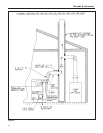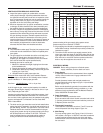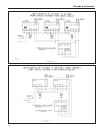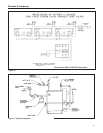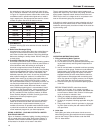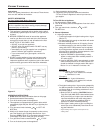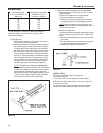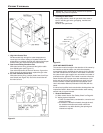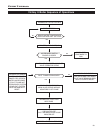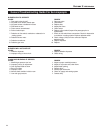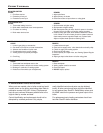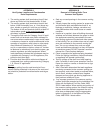
VI
CTORY
II V
HS Models
22
3. Perform “Venting System Regular Inspection” on
Page 14.
C
. Piping
Check the following:
1. Water piping and accessories for leaks. Slightest
l
eaks should be corrected.
2. System to be full of water and pressure to remain
stable at correct setting on gauge.
3. Air-control system. Noise and air binding in radia-
tion should not occur.
4
. Low water cutoff for operation (see instructions fur-
nished with unit).
D. Boiler Room Air Supply
C
heck air vents for continued positive supply of air as
required. Air needs are greatest in cold weather. Air
vents must be open and free of obstruction.
WARNING: The flow of combustion and ventilating air to
the boiler should not be obstructed.
2. Inspection During Heating Season
A. Check water pressure regularly and add water slowly
to system when needed. If much water is added, vent-
ing may be necessary. Regular loss of water from boil-
er system may indicate either a system leak, or a
faulty air control system, or a faulty automatic fill valve.
B. Check venting system. See “Venting System Regular
Inspection” on Page 14.
C. Check condensation drain trap to be full of water.
Check for deterioration of the tubing. Check that the
trap is not plugged.
3. Annual Inspection and Cleaning
The following must be done by a competent serviceperson
to help insure safe and reliable operation:
A. Flue passage cleaning
See Figure 23. It is suggested that paper be placed on
burners to collect any foreign material in cleaning
flues.
1. Remove control box (see instruction under “Safety
Check”. See Figure 20).
2. Remove jacket top.
3. Remove inducer assembly.
4. Remove flue collector.
5. Use wire brush to clean flue passages.
6. Replace flue collector and re-seal with furnace
cement.
7. Replace inducer assembly, jacket top and control
box.
8. Remove and dispose of paper and accumulated
material.
B. Cleaning of burners
If burners’ surfaces are not clean, or uneven flame
indicates plugged burner parts, remove and clean
burners.
1. Remove pilot gas line at gas valve.
2. Disconnect pilot burner assembly from pilot bracket.
3. Lift burner and remove burner from orifice.
4. Clean burners. To clean burners, run a clean flue
brush up the tube until all foreign matter is
removed.
5. Replace burners, pilot assembly, ignitor and sensor
wires.
6. Adjust burners and pilot assembly.
C. Re-check of input gas rate of burners. See “Burner
Adjustment” on Page 19.
D. Re-adjusting for best flame characteristics of main
flame and pilot burner flame. See “Burner Adjustment”
on Page 19.
E. To prolong the life of inducer motor, lubricate with
Anderol 465 or SAE 20 motor oil annually. Turn off
power and place 4-6 drops of above mentioned lubri-
cate in each of two oil holes. Lubricate circulator per
manufacturer’s instruction. DO NOT over oil any motor.
Figure 23.
WARNING:
The ceramic combustion chamber in the burner box
contains crystalline silica.
Wear proper dust mask and glo
ves when servicing
combustion chamber or burners.
Crystalline Silica has been identified as a carcinogen or
possibly carcinogenic to humans.



